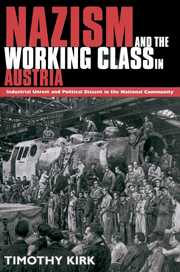 Nazism and the Working Class in Austria
Nazism and the Working Class in Austria Book contents
- Frontmatter
- Contents
- List of tables
- Acknowledgements
- Maps
- Introduction
- 1 Austrian fascisms, ‘Austrofascism’ and the working class
- 2 Economic integration and political opposition between the Anschluss and the war
- 3 The war economy and the changing workforce 1939–1945
- 4 Work discipline in the war economy
- 5 Popular opinion and political protest in working-class communities
- Conclusion
- Notes
- Select bibliography
- Index
1 - Austrian fascisms, ‘Austrofascism’ and the working class
Published online by Cambridge University Press: 06 January 2010
- Frontmatter
- Contents
- List of tables
- Acknowledgements
- Maps
- Introduction
- 1 Austrian fascisms, ‘Austrofascism’ and the working class
- 2 Economic integration and political opposition between the Anschluss and the war
- 3 The war economy and the changing workforce 1939–1945
- 4 Work discipline in the war economy
- 5 Popular opinion and political protest in working-class communities
- Conclusion
- Notes
- Select bibliography
- Index
Summary
Austrian politics
The history of modern Austrian politics has generally been described in terms of three broad political movements or ‘camps’ (Lager): the labour movement, the ‘Catholic-conservative’ camp and the ‘national-liberal’ camp. All three movements originated to some extent in the broad spectrum of radical political opposition to Austrian liberalism in the last quarter of the nineteenth century, and their earliest leaders moved in the same political and intellectual circles in Vienna. This tripartite structure has constituted the framework within which parliamentary parties have operated in Austria since the emergence of popular politics, and has proved a remarkably stable model, still recognisable in the political history of the Second Republic.
There is much to be said for the ‘tripartite interpretation’ of Austrian politics; it is worth distinguishing, for example, the clerical from the anti-clerical Right. Nevertheless, it is not without its problems, especially when applied to the political Right between the wars. The Christian Socialists and the German nationalists acted in accordance with the practical political imperatives that united them, rather than the ideological differences that divided them. Although the existence of three separate parties always made other types of coalition possible, the only one that was ever formed after 1920 was a ‘bourgeois bloc’ made up of the Christian Social Party (CSP) and the Greater German People's Party (Groβdeutsche Volkspartei, GDVP). Coalition with the Social Democrats was unthinkable for either. Similarly, although both the rank and file of the two parties and their electoral constituencies differed, both parties represented essentially middle-class interests, and each was motivated by a determination to exclude the Social Democratic Workers' Party (Sozialdemokratische Arbeiterpartei, SDAP) from power.
- Type
- Chapter
- Information
- Nazism and the Working Class in AustriaIndustrial Unrest and Political Dissent in the 'National Community', pp. 19 - 47Publisher: Cambridge University PressPrint publication year: 1996
